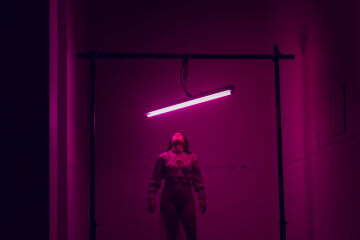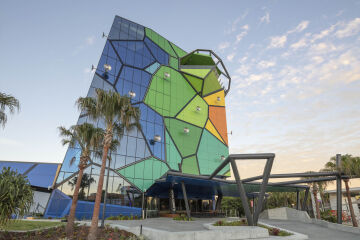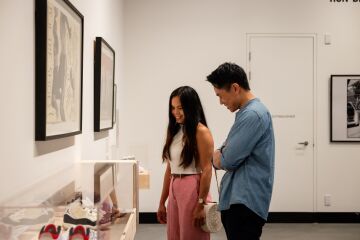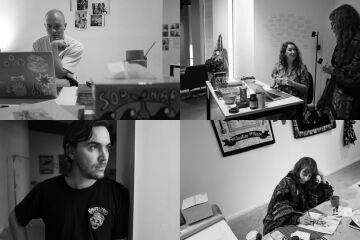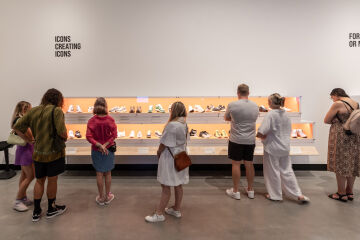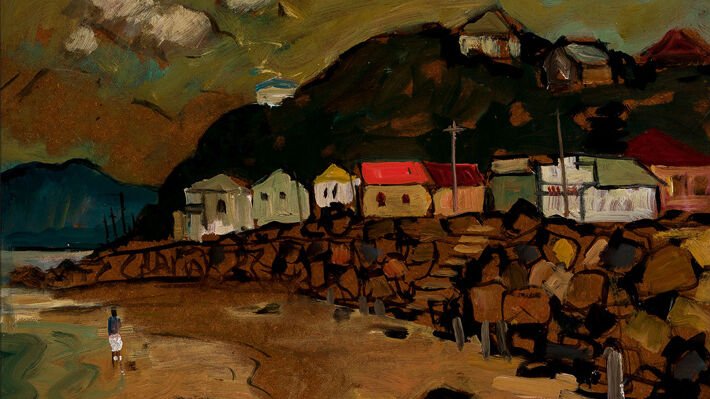
As we all find ourselves spending time alone, John Rigby’s painting of a solitary figure walking on Currumbin Beach feels like a timely part of the City Collection.
The City Collection, which includes more than 5000 works of art and includes one of the largest collections of Aboriginal and Torres Strait Islander art in regional Australia, contains many significant works of art.
In preparing to put the collection on show in the new HOTA Gallery our curatorial team have been researching key works, reflecting on them in new pieces of writing. Here, Curator Bradley Vincent examines John Rigby’s Currumbin, finding a beautiful rendering of a Gold Coast of yesteryear:
‘In 1956, the Gold Coast was a small coastal town with population of around 20,000 people. Towards its Southern end, Currumbin Beach was marked by just a small row of timber houses. A couple more perched on the hill above, overlooking the scene. It is a far cry from the shoreline and city that we know today. Currumbin (1956) is a small, beautifully painted record of the time and of the city as it was then. The warmth of the painting, with its rich oil-on-board hues, creates a scene that is bathed in a glow, perhaps now of nostalgia.'
‘The painting is from the early career of John Rigby, a Brisbane-born artist much regarded for his landscapes and portraits for a period spanning over 60 years. Its career- earliness makes Currumbin a particularly special moment in the City Collection. Having completed studies at Sydney’s National Art School, Rigby had recently returned to Queensland and was experiencing growing appreciation of his work. In the 1954 he held his first solo exhibition and in 1956 he was to set out for Italy, having won a prestigious travelling art scholarship the previous year. This Italian experience would prove formative for Rigby, but one can already see in Currumbin a deep affinity with the tradition of landscape painting, as well as a modern and sophisticated understanding of composition and colour. It is a painting that showcases the talent and vibrancy of the young Rigby.
‘Currumbin captures the textures of the coastal scene with efficiency and energy – each element given care, conjured in a fading light. The rock wall that divides the centre of the picture is lined-in brusquely, filled just where it is needed with mineral daubs of paint. A set of stairs are rudimentarily marked into the terrain while ghostly grey wooden poles mark where the dark golden beach begins. The ocean just barely pushes into the left-hand side of the frame. A few blue grey strokes, their quickness befitting the shimmer of water as it runs across the sand. A single figure walks the waterline, their back to us. A row of houses, of recognisable, simple architecture, line the foreshore. They are the kind that were once dotted right along the coast, barely remaining now. Their array of coloured roofs are the last, brightest remains of the darkening day: orange, yellow, green and rusted iron. They stand out against the hills in shadow, glossy and black. The sky above is painted quick and changing. With its stilled but energetic textures, this modest sized landscape is a beautiful rendering of a particular moment in a day.
‘In paintings such this, the City Collection holds a record of the city as it was. And John Rigby is amongst the best of those to captured it.’
You’ll be able to see this work, plus other gems of the City Collection in the new HOTA Gallery when we throw open the doors in 2021.
Image credit:
John Rigby (b.1922, d.2012) Currumbin. 1956. Oil on board
Collection, Gallery at HOTA. Gifted by the citizens of the Gold Coast to future generations 1996
Image courtesy the John Thomas Rigby Family.
Subscribe now for Art in your inbox
News, special offers, events, competitions, and arts & culture updates on the Gold Coast. All the good stuff.

